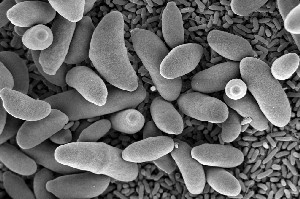Dehalococcoides ethenogenes: Difference between revisions
| Line 11: | Line 11: | ||
''Dehalococcoides ethenogenes'' (strain 195) | ''Dehalococcoides ethenogenes'' (strain 195) | ||
[[Image:Dehalococcoides_ethenogenes.jpg|right|thumbnail|3-d image | [[Image:Dehalococcoides_ethenogenes.jpg|right|thumbnail|3-d image of bacteria | ||
www.mdsg.umd.edu]] | www.mdsg.umd.edu]] | ||
Revision as of 17:59, 5 June 2007
A Microbial Biorealm page on the genus Dehalococcoides ethenogenes
Classification
Higher order taxa
Domain: Bacteria; Phylum: Chloroflexi; Class: Dehalococcoidetes; Order: Dehalococcoides
Species
Dehalococcoides ethenogenes (strain 195)
Description and significance
Dehalococcoides ethenogenes has many cellular features. This bacteria is Gram-positive, which generally means it has a very thick cell wall and a single membrane layer. From a three-dimensional prospective, it appears to have an irregular, spherical shape. The species moves spontaneously and independently. It is most suitable in moderate temperature environment around 25 and 40°C with an optimal temperature of 35°C. In the bacteria, there does not exist the following electron acceptors: oxygen, nitrate or sulfate (formally known as anaerobic). It can live in multiple habitats because it has a living temperature similar to soil, the human body, animals, etc. Thankfully, it is not pathogenic, which means it doesn't spread diseases or illnesses its host.
This specific strand of genome was sequenced, and it was discovered to help decontaminate toxic chemicals in many industries. Specifically, this species reduces chlorinated hydrocarbons in contaminated environments. Chlorinated hydrocarbons are significantly toxic to humans. Also, it can cause irreparable damage in groundwater areas when the chemical is not handled properly.
This organism can be isolated from environments polluted with chemicals such as PCE and trichloroethane (TCE).
Genome structure
Dehalococcoides ethenogenes has many features in its genome. The total nucleotide base pairs in this genome is around 1,469,720 or 1.5 Mb. It has one chromosome referring to strain 195. The species has a circular shape, although not perfectly circular (irregular coccus). It is the only known bacterium which completely dechlorinates tetrachloroethene (PCE) and trichloroethene, to ethylene. This is important because PCE and trichlorothene are common chemical groundwater pollutants featured in many commercial industry cleaners.
Apparently, Dehalococcoides ethenogenes has plasmids called pUA969, pUA970, pUA971. These plasmids work to bind D. ethenogenes LexA gene to Bacillus subtilis. This is significant because it makes the first Gram-negative bacterium sharing LexA binding site like that of B. subtilis.
Cell structure and metabolism
PCE, carriers of D. ethenogenes, can be metabolize for energy by at least 15 different organisms such as acetogens and methanogens. Acetogens can use PCE to produce energy and carbon. The most common energy and carbon produced are carbon dioxide and hydrogen, respectively. Methanogens also produce energy and carbon of the same kind. Where they differ is some carbon dioxide will react with hydrogen to produce methane, which creates a gradient that generates ATP. Basically, these organisms benefit from PCE, which halococcoides ethenogenes stems. Some organisms in this category produce energy from tetrachloroethene. These organisms are able to react with hydrogen (carbon source) as the electron donor, indicating that hydrogen and PCE serve as electron donors or acceptors for energy growth. The exchange of electrons are responsible for the generation of energy through PCE.
Ecology
Dehalococcoides ethenogenes most common use is for cleaning toxic messes by PCE. PCE is a suspected human carcinogen. Basically without this bacterium, PCE cancer spread to the human bodies and animals. The symptoms of short-term exposure to PCE cause dizziness, headaches, and problems with balance, while long-term exposure of PCE has been linked to cancers of the esophagus, bladder, and blood. Therefore, D. ethenogenes is used to manipulate PCE and to minimize its symptoms. Not only does D. ethenogenes stop the spread of cancer to humans, but protect the groundwater that are PCE exposed.
Pathology
This organism can be known as pathogen-free. It does not produce disease or illness to its host.
Application to Biotechnology
Dehalococcoides ethenogenes is only known bacteria that can breakdown PCE, a dangerous and toxic carcinogen in chemical working environments. This organism converts PCE and hydrogen to chlorine and ethene, which render the toxin completely harmless. The bacteria "come in stainless steel vessels that contain roughly 2000 billion Dehalococcoides bacteria ready for injection into groundwater" (495). This system of removing contamination from groundwater was named "pump-and-treat". Basically, they would inject the bacteria into groundwater to convert PCE into ethylene. Research indicates that the level of ethylene rises; therefore, the injection was an success.
Current Research
1) The solvents tetrachloroethene (PCE) and trichloroethene (TCE) are among the most pollutants at contaminated groundwater sites. Under aerobic conditions, PCE is considered can't be reduced, while TCE can be broken down to non-toxic products. This poses a problem because PCE is a harmful chemical to the environment, but cannot be controlled when oxygen is present. Therefore, there are flaws that D. ethenogenes cannot fix completely. However under anaerobic conditions, PCE and TCE have been able to reduce to ethylene, which deems them more or less harmless.
2) Bioremediation Consulting Inc. (BCI), of Watertown, Massachusetts identified at least 4 natural microbes containing Dehalococcoides ethenogenes that are known as TCA-tolerant D. ethenogenes. Also, found growing there was Dehalobacter. TCA is converted to chloroethane by Dehalobacter. Figure 1 shows complete treatment of both TCA and TCE in 12 weeks by the native microbes. Figure 2 is a graph of growth of this culture, showing dechlorination TCE and DCE to ethene and TCA dechlorinated to chloroethane. This research indicated the difference between using natural microbes or bacteria like Dehalobacter to treat the contaminated areas.
3) Today, in the United States, the bacteria have been used to clean up chlorinated solvents in ten states at 17 sites including Kelly Air Force Base in Texas and Caldwell Trucking Superfund Site in New Jersey. For SiREM, business has been good; 13 of the sites were done in the past 18 months.
References
Duhamel et al. 2002, Water Research, Vol 36, p 4193
Maymo-Gatell, X., 1997, Science, Vol 276
B. Sun et al., 2002, Science, Vol 298 p. 1023
Edited by Tim Hou of Rachel Larsen and Kit Pogliano




